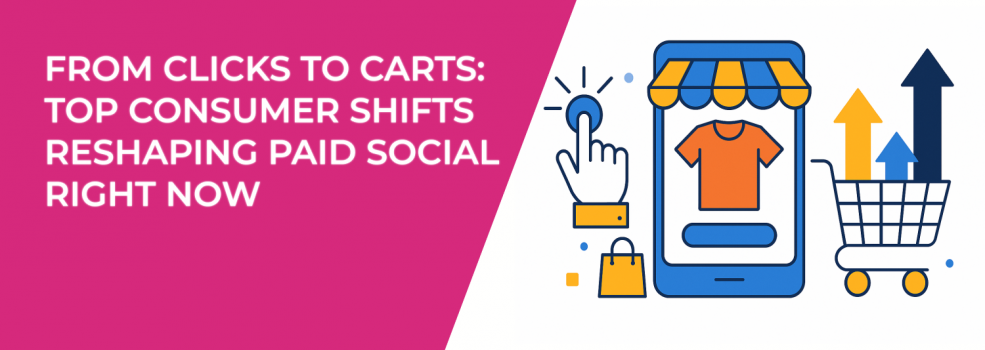Paid social is moving fast. The way people scroll, shop, and decide is changing every month. What used to work smoothly can suddenly lose traction, and brands that don’t keep up risk wasting budget.
So, what are today’s consumers really doing — and how should advertisers respond? Let’s look at the biggest shifts happening right now and what you can do to stay ahead.
1. From Browsing to Buying: Shopping Happens on Social
Social media isn’t just about discovery anymore. It’s where people shop. TikTok, Instagram, and Facebook now let users see a product, tap it, and buy it on the spot. No website needed.
Social commerce is growing so quickly that by 2025 it’s expected to make up nearly 20% of all e-commerce sales worldwide. That’s a big slice of the pie — and you don’t want to miss it.
Here’s how you can take advantage. Keep it simple and remove as many steps as possible.
-
Sync your product catalog with platforms like Facebook and Instagram Shops.
-
Run shoppable video ads that let people check out instantly.
-
Watch for checkout drop-offs and fix bottlenecks quickly.
When buying feels effortless, ads stop being just attention-grabbers — they turn into cash registers. And if you need a strong targeting foundation before you scale, bookmark this primer: Facebook Ad Targeting 101: How to Reach the Right Audience.
2. Shoppers Are More Value-Conscious
People are careful with money. They’ll save on everyday items but spend more freely on products that feel special — whether that’s fitness gear, luxury skincare, or tech.
This means one-size-fits-all pricing strategies don’t cut it. “Value” can mean price, sustainability, quality, or even status.
Try lining up your message with what matters most to your audience. The tactics below help you find that fit.
-
Position products around the right value driver: affordability, eco-friendliness, or exclusivity.
-
Show long-term value, like durability or savings over time.
-
Offer bundles or subscriptions for better perceived savings.
When you connect with how your audience defines value, your ads land with more clarity and less waste.
3. Trust Is Shaky, But Social Still Sells
Here’s the twist: people say they don’t fully trust social media, but they still make buying decisions based on it. Why? Because they trust the voices on these platforms — friends, creators, and communities.
Authenticity beats polish. Around 80% of people say they’re more likely to buy when content feels real.
Lean into credibility and community. The following moves make a difference.
-
Work with smaller influencers who already have loyal communities.
-
Encourage reviews and user-generated content from real customers.
-
Match the tone of the platform so your ads feel native, not forced.
When your brand feels like part of the conversation, people listen. If engagement is your growth lever, this playbook helps: How to Use Instagram Reels in Your Marketing Strategy.
4. Convenience Wins Every Time
Nobody wants to waste time. If your ad makes buying too complicated, you lose the sale.
Look at your funnel from the user’s point of view and remove every extra step. Small fixes can create a big lift in conversions.
Start with these friction-killers, then measure the impact.
-
Use pre-filled lead forms that save time.
-
Offer instant checkout options.
-
Highlight fast shipping and easy returns inside the ad.
-
Retarget cart abandoners with a reason to finish.
The easier you make it to buy, the more likely people are to come back. For a focused guide on reclaiming missed revenue, see Using Facebook Retargeting to Increase Cart Recovery Rates.
5. Personalization Without Overstepping
People like relevant ads. They don’t like creepy ads. Striking the balance is tricky, especially with privacy changes and fewer third-party tracking options.
Instead of chasing users around the internet, use signals they willingly give you. That’s where smart personalization starts.
Here are practical, privacy-aware ways to stay relevant.
-
Build segments from engagement signals like video views, clicks, or saves.
-
Offer opt-ins through discounts or exclusive content to collect preferences.
-
Personalize based on behavior rather than sensitive demographics.
Helpful beats invasive. If you’re rethinking your data approach, this deep dive is worth a read: Zero-Party Data and Facebook Ad Targeting: The Future of Custom Audiences.
6. Shoppers Care About Purpose and Sustainability
More buyers ask bigger questions. Is the product responsibly made? Is packaging sustainable? Does the brand stand for something meaningful?
If your ads skip these answers, you may lose ground to brands that show their impact clearly.
Bring your values into your creative, then back them up with proof.
-
Highlight eco-friendly sourcing or packaging in your ads.
-
Share quick stories about real community or environmental impact.
-
Show customers how their purchase supports something positive.
Purpose builds trust — and trust builds repeat sales.
7. Video Rules the Feed
Short-form video dominates. TikTok, Reels, and Shorts now grab most of the attention. Static images still work, but video drives higher recall and faster understanding.
Keep videos short, useful, and human. Then test and iterate.
-
Use quick demos to show benefits in seconds.
-
Share behind-the-scenes clips to humanize your brand.
-
Create snackable edits tailored to fast scrolling.
If you want to stop the scroll, video is the main event.
8. Buying Is Shaped by Communities
People aren’t just influenced by ads — they’re influenced by groups. Facebook Groups, Reddit threads, and niche communities can make or break a product.
Don’t just advertise to communities. Participate in them.
-
Build spaces where your customers can interact, like branded groups.
-
Start useful discussions in relevant communities.
-
Show social proof in your ads — reviews, counts, or milestones.
Community endorsement brings built-in trust you can’t buy outright.
9. Shopping Journeys Are Messy and Hybrid
The path to purchase isn’t straight. A shopper might discover you on TikTok, compare on Amazon, read reviews on YouTube, and finally buy on Instagram.
One ad rarely closes the deal, so design for the whole journey.
-
Retarget across multiple platforms to stay present during research.
-
Build funnels that guide users smoothly from one app to another.
-
Track assisted conversions, not just last-click wins.
Think of your media as a relay team — each touch passes the baton closer to the finish line. And if performance slides mid-funnel, this troubleshooting guide helps you course-correct fast: Facebook Ads Not Converting: How To Fix It.
Final Thoughts
From clicks to carts, consumers are reshaping how paid social works. They want speed, value, and authenticity. They reward brands that care about purpose and trust, and they spend more time in video and communities than ever.
Advertisers who adapt — by making buying easy, leaning into video, tightening targeting, and respecting privacy — won’t just keep up. They’ll stand out.
So here’s the question: are you ready to adjust your paid social strategy before your audience leaves you behind?

